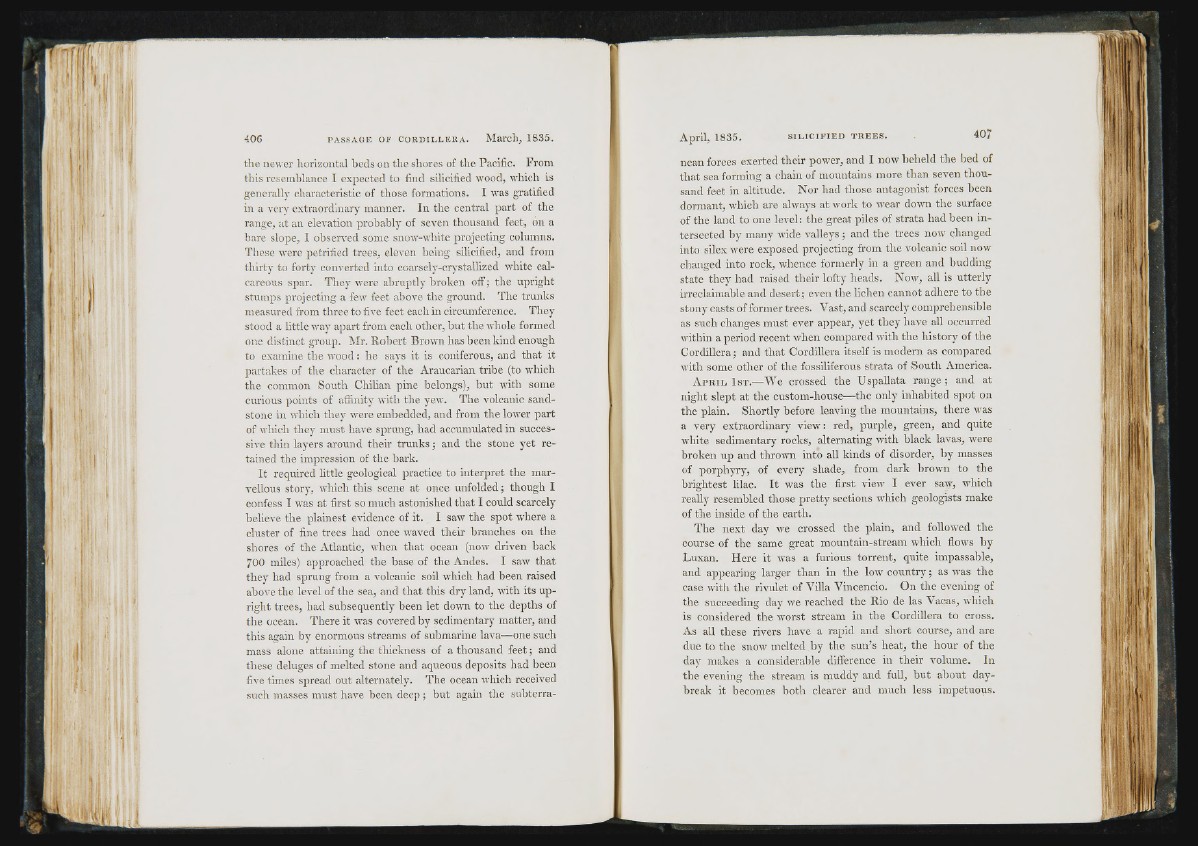
I. !
' i!:'
I t i ; 7
!' . t.
'ri'. '
the newer horizontal heds on the shores of the Pacific. From
this resemblance I expected to find silicified wood, which is
generally characteristic of those formations. I was gratified
in a very extraordinary manner. In the central part of the
range, at an elevation probably of seven thousand feet, on a
bare slope, I observed some snow-white projecting columns.
These were petrified trees, eleven being silicified, and from
thirty to forty converted into coarsely-crystallized white calcareous
spar. They were abruptly broken off; the upright
stumps projecting a few feet above the ground. The trunks
measured from three to five feet each in circumference. They
stood a little way apart from each other, but the whole formed
one distinct group. Mr. Robert Brown has been kind enough
to examine the wood: he says it is coniferous, and that it
partakes of the character of the Araucarian tribe (to which
the common South Chilian pine belongs), but with some
curious points of affinity with the yew. The volcanic sandstone
in which they were embedded, and from the lower part
of which they must have sprung, had accumulated in successive
thin layers around their trunks; and the stone yet retained
the impression of the bark.
It required httle geological practice to interpret the marvellous
story, which this scene at once unfolded; though I
confess I was at first so much astonished that I could scarcely
believe the plainest evidence of it. I saw the spot where a
cluster of fine trees had once waved their branches on the
shores of the Atlantic, when that ocean (now driven back
7 0 0 miles) approached the base of the Andes. I saw that
they had sprung from a volcanic soil which had been raised
above the level of the sea, and that this dry land, with its upright
trees, had subsequently been let down to the depths of
the ocean. There it was covered by sedimentary matter, and
this again by enormous streams of submarine lava—one such
mass alone attaining the thickness of a thousand fe e t; and
these deluges of melted stone and aqueous deposits had been
five times spread out alternately. The ocean which received
such masses must have been deep; but again the subterraApril,
1835.
nean forces exerted their power, and I now beheld the bed of
that sea forming a chain of mountains more than seven thousand
feet in altitude. Nor had those antagonist forces been
dormant, which are always at work to wear down the surface
of the land to one level; the great piles of strata had been intersected
by many wide valleys ; and the trees now changed
into silex were exposed projecting from the volcanic soil now
changed into rock, whence formerly in a green and budding
state they had raised their lofty heads. Now, all is utterly
irreclaimable and desert; even the lichen cannot adhere to the
stony casts of former trees. Vast, and scarcely comprehensible
as such changes must ever appear, yet they have all occurred
within a period recent when compared with the history of the
Cordillera; and that Cordillera itself is modern as compared
with some other of the fossiliferous strata of South America.
A p r i l 1 s t .—We crossed the Uspallata range; and at
night slept at the custom-house—the only inhabited spot on
the plain. Shortly before leaving the mountains, there was
a very extraordinary v iew: red, purple, green, and quite
white sedimentary rocks, alternating with black lavas, were
broken up and thrown into all kinds of disorder, by masses
of porphyry, of every shade, from dark brown to the
brightest lilac. It was the first view I ever saw, which
really resembled those pretty sections which geologists make
of the inside of the earth.
The next day we crossed the plain, and followed the
course of the same great mountain-stream which flows by
Luxan. Here it was a furious torrent, quite impassable,
and appearing larger than in the low country; as was the
case with the rivulet of Villa Vincencio. On the evening of
the succeeding day we reached the Rio de las Vacas, which
is considered the worst stream in the Cordillera to cross.
As all these rivers have a rapid and short course, and are
due to the snow melted by the sun’s heat, the hour of the
day makes a considerable difference in their volume. In
the evening the stream is muddy and full, but about daybreak
it becomes both clearer and much less impetuous.
ri’J
lit ’
S'